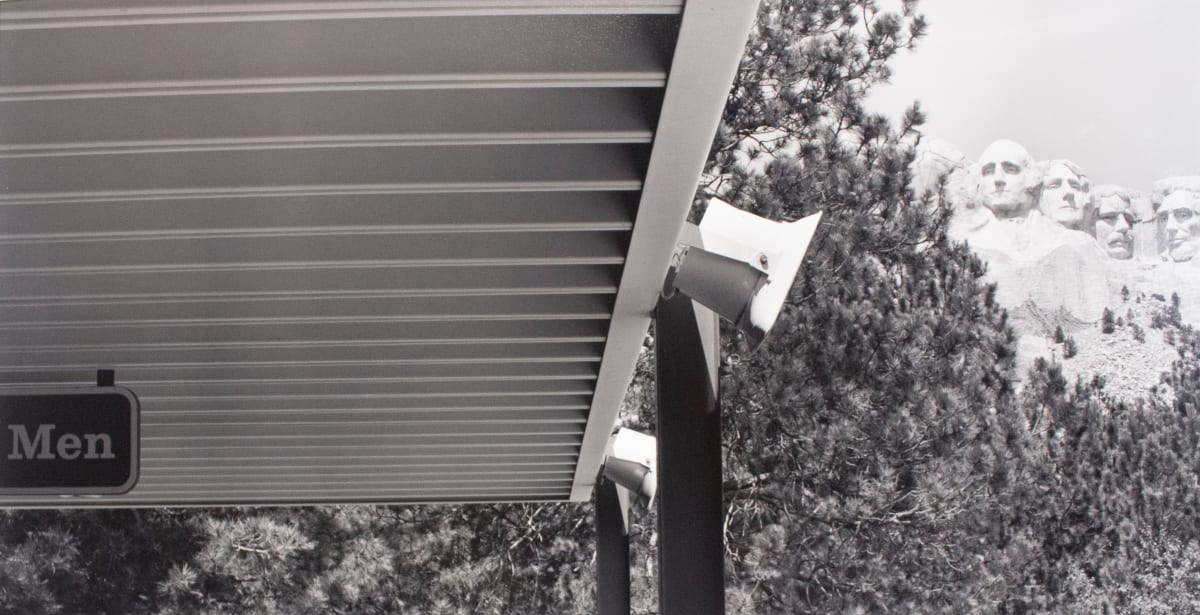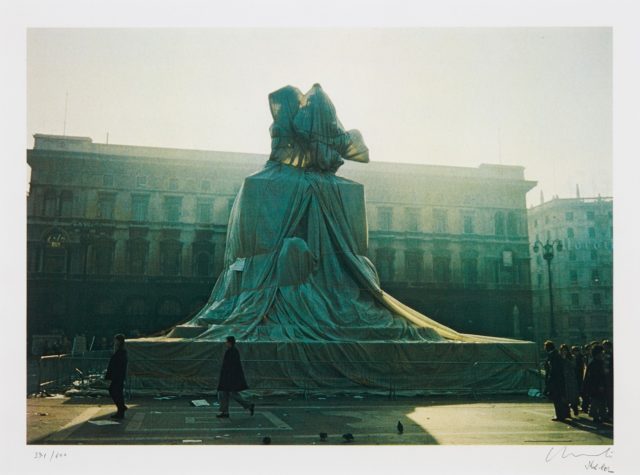Christo (American, Bulgarian-born, 1935-2020)
Wrapped Monument to Vittorio Emanuele, Piazza del Duomo, Milan, 1970
Colored photolithography on cardboard
14.5 x 19.5 in
On loan from John Andrew MacMahon, Class of 1995
Christo’s Wrapped Monument to Vittorio Emanuele, Piazza del Duomo, Milan and Michelle Van Parys’s Men can be found on view in Chambers Building.
Please note: All buildings on campus, including Chambers, are only open to Davidson students, faculty, and staff due to the pandemic.
These two photographic prints are paired together to further contemplate the current socio-political environment in which we dwell.
Christo’s Wrapped Monument to Vittorio Emanuele, Piazza del Duomo, Milan depicts the site-specific, temporary installation of a monument wrapped in polypropylene fabric for two days during the fall of 1970 in Milan, Italy. Christo’s wrapped monument draws parallels to today’s society, as the United States confronts its ongoing history of racial injustice. Within the past months, Confederate monuments have been removed from capitol grounds and city streets on vast a scale. The removal of these structures denounces racism and incites a need to expose those lives who are chosen to be memorialized via public monuments. These actions are a small step in addressing and challenging racist structures in order to seek justice and advocate for the lives of people of color in America.
In Men, Michelle Van Parys captures a view of Mount Rushmore from the entrance to the men’s restroom. The word “Men” and a loudspeaker command the foreground, while the iconic monument rests in a cloud of pine in the background. Van Parys’ framing of “men” (both in the memorial and in the restroom signage) with the loudspeaker still holds poetic resonance today, nearly 30 years after this photo was taken. Whose voice sounds on the loudspeaker, and what are they saying? Our nation is in the middle of a reckoning of what to do with monuments. Van Parys’s photograph calls attention to the metaphorical loudspeaker of patriarchal colonialism, which obscures the circumstances in which monuments like Mount Rushmore came to be.
The National Parks Service explains “[t]he purpose of the [Mount Rushmore] memorial is to communicate the founding, expansion, preservation, and unification of the United States,” but the history of how the monument came to be tells a different story. The land on which the monument sits was forcibly taken from the Lakota Sioux. The four presidents’ faces are carved into the Black Hills, which are sacred ground. How can Mount Rushmore possibly be a memorial to the unification of America when it was built on stolen and desecrated Indigenous land?

To learn more about how art can provide insight into the world we are currently living in, check out our current exhibition, From Pandemic to Protests, by clicking the link below.
The practice of wrapping structures in the built environment was common for Christo and Jeanne-Claude, who worked together as collaborative partners their entire career. Their work has been exhibited all over the world, yet it is impermanent: only existing in the form of photographs and memory. Their projects continue to be realized even after both of their deaths, with Christo most recently passing May 31, 2020.
Van Parys earned her MFA in Photography from Virginia Commonwealth University. Her photographs have been exhibited internationally and can be found in public collections such as the Portland Art Museum. She is the recipient of the Virginia Museum Fellowship and the South Carolina Arts Commission Fellowship, and she currently teaches studio art at the College of Charleston.
Emilie Hoke ’21

